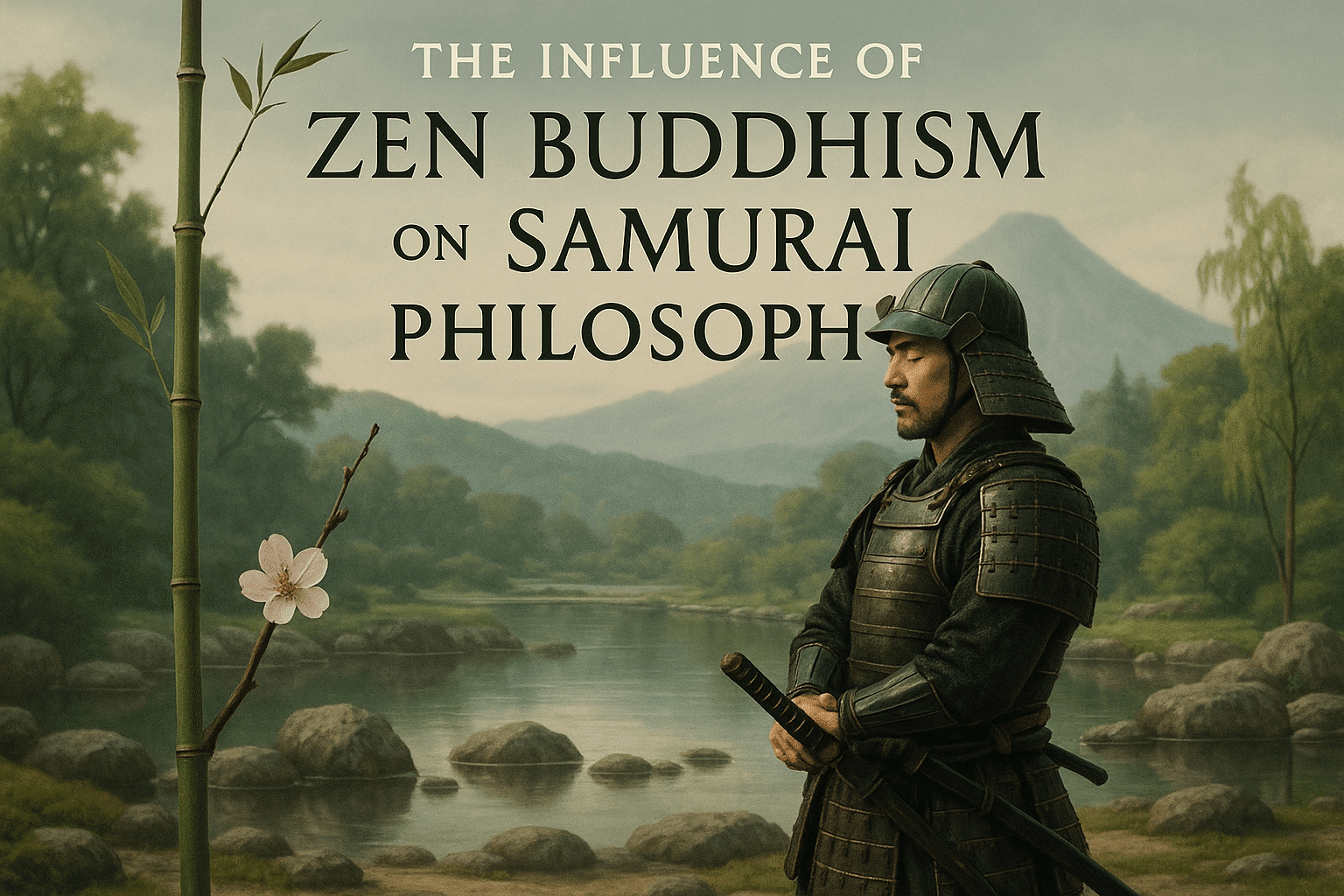Introduction: Stillness Before the Storm
In the hushed moments before battle, when steel waits to sing and breath slows to a whisper, the samurai found ground not in fear, but in stillness. This poised silence, far more than mere calm, was cultivated through a rigorous inner discipline—nurtured and sharpened by the teachings of Zen Buddhism. Unlike the clamor of swords or the blaze of war cries, Zen offered the warrior a subtler weapon: clarity.
At the heart of the samurai’s path was more than martial skill—it was a quest for self-mastery. Zen’s embrace of impermanence, detachment, and direct experience harmonized with the way of the warrior, forging an identity where fear was confronted with presence, and death accepted with grace. As we delve deeper into the philosophical undercurrents that shaped the samurai spirit, it becomes clear: their true strength came not only from how they fought, but from the stillness they carried into the fight.
Zen Buddhism in Japan: The Seeds of Stillness
Zen Buddhism made its way to Japan from China in the 12th century, finding fertile ground in a nation already steeped in ritual, discipline, and reverence for simplicity. Introduced primarily through the efforts of monks like Eisai and Dōgen, Zen—derived from the Chinese Chán school—emphasized direct experience over doctrinal study, meditation (zazen) over scripture, and inner clarity over outward display. These principles would profoundly shape not only Japanese religious life but also the temperament and ideology of its warrior elite.
For the samurai, Zen offered more than spiritual solace—it provided a philosophical framework that mirrored their lived experience. The discipline of zazen, with its focus on presence and acceptance of impermanence, echoed the uncertainty and immediacy of life on the battlefield. The samurai found in Zen a path to mental stillness amid chaos, a way to hone intuition and decisive action, free from hesitation or fear of death.
Zen’s austerity and emphasis on personal mastery aligned seamlessly with the bushidō code, cultivating a warrior ethos of inner calm, self-control, and unwavering resolve. Monasteries became centers of both spiritual and martial training, where sword and meditation complemented each other. Over time, Zen came to influence not only samurai conduct but also cultural expressions like ink painting, garden design, and the tea ceremony—each embodying the Zen pursuit of profound simplicity.
Thus, in the quiet halls of Zen temples and the silent pause before a drawn sword, the seeds of stillness took deep root in the soul of the Japanese warrior.
The Samurai Spirit: A Discipline of Death and Duty
The samurai way of life, steeped in the principles of bushidō, was inseparable from the ideals of death, discipline, and duty. Central to their code were unwavering loyalty, unflinching courage, and a relentless pursuit of honor—even in the face of annihilation. These values did not emerge in a vacuum; they found potent reinforcement in the teachings of Zen Buddhism, which offered a spiritual framework perfectly suited to the samurai’s austere existence.
Zen’s emphasis on living fully in the present moment mirrored the samurai’s readiness to die at any time. Death was neither feared nor avoided—it was accepted as an essential component of life. In Zen, the idea of “no-mind” (mushin) taught one to act without attachment or hesitation, training warriors to face combat with calm precision and inner clarity. This mental discipline allowed the samurai to quiet fear and maintain focus, even when life hung by a thread.
Honor and loyalty were also deepened by Zen’s teachings on impermanence and selflessness. True service, according to both bushidō and Zen, stemmed from the dissolution of ego. A samurai risked all not for personal glory, but for a higher cause—a master, a clan, or the sanctity of a vow. In cultivating detachment and humility, Zen helped sharpen their moral resolve, forging warriors who fought not for the sake of violence, but in the spirit of righteous duty.
Thus, the samurai spirit was not only defined by the blade but by a profound internal discipline. It was the path of clarity in chaos, serenity amidst slaughter—a spiritual code that found perfect harmony with Zen’s stark and steady flame.
Harmony in Action: How Zen Shaped Bushidō
The fusion of Zen Buddhism and Bushidō, the ethical code of the samurai, created a philosophy rooted in clarity, discipline, and presence. At the heart of this synthesis was the Zen acceptance of impermanence and death—a concept seamlessly woven into the fabric of the warrior’s way. For the samurai, contemplating mortality was not morbid, but liberating. Zen taught that by embracing the inevitability of death, one could live—and fight—with unflinching focus and purpose. This principle became central to Bushidō, where fearlessness wasn’t recklessness but clarity born from acceptance.
Mindfulness, another cornerstone of Zen, sharpened a samurai’s awareness both in training and on the battlefield. By practicing zazen (seated meditation) and cultivating moment-to-moment attention, warriors honed their intuition and reaction time—key attributes in martial pursuit. The ability to stay calm amid chaos made Zen not just philosophy, but also a practical discipline in life-or-death encounters.
Equally vital was the Zen ideal of non-attachment. Samurai were trained to act without clinging to outcomes or emotion—mirroring Zen’s teaching of detachment from ego and desire. This detachment didn’t mean apathy; rather, it encouraged stoic resolve and moral clarity. A warrior guided by Bushidō didn’t fight for glory or revenge but for duty, honor, and balance—all resonant with Zen’s call for an ego-less existence.
In essence, Zen didn’t soften the samurai—it sharpened him. Through death’s acceptance, mindful presence, and detachment from self, Zen transformed Bushidō from a mere code of conduct into a profound way of being.
Meditation and the Martial Path
Amid the intensity and discipline of the samurai life, meditation—particularly the Zen practice of zazen (seated meditation)—emerged as a cornerstone of mental training. Zazen wasn’t just a spiritual exercise; it was a method for sharpening awareness, cultivating presence, and preparing the mind for the unpredictability of battle.
Through silent sitting and focused breathing, samurai learned to calm distracting thoughts and emotions, accessing a state of mushin, or “no-mind.” In this condition, the practitioner responds instinctively, without hesitation or ego—qualities vital in combat where a split second could decide life or death. Zazen fostered composure under pressure, improved reaction time, and enhanced decision-making, empowering the warrior to act with clarity even amid chaos.
For the samurai, the battlefield was both a physical and a mental arena. Meditation served as internal training, complementing their martial skills and reinforcing a mindset rooted in discipline, presence, and enlightened awareness.
Life, Death, and Emptiness: Embracing Impermanence
For the samurai, life was a fleeting moment, as delicate and transient as the cherry blossoms they revered. Central to their understanding of existence was the Zen Buddhist principle of impermanence—mujō—which teaches that all phenomena are in a constant state of flux. Nothing lasts, and everything changes. Far from being a source of despair, this realization was a source of liberation. By accepting that death could come at any moment, the samurai were empowered to fully engage with life, cultivating clarity, courage, and discipline in every action.
Zen urged these warrior-monks to detach from clinging—whether to fear, to victory, to status, or even to survival. Meditation on death was not morbid but transformative; it stripped life of illusion, sharpening purpose. This is exemplified in the practice of writing death poems—spare and poetic reflections composed before battle or upon sensing death’s approach. In these verses, one sees the serenity forged by Zen practice, the ability to meet the end without regret or hesitation.
In embracing impermanence, the samurai found not sadness, but focus. Zen taught them that only through letting go could they act with true presence—each sword stroke, each decision, imbued with mindful awareness. This surrender to transience was not weakness, but an ultimate affirmation of life’s sacred immediacy.
Legacy and Reflection: Zen Echoes in Modern Martial Arts
The disciplined calm of the samurai did not vanish with the sword—it endures in modern dojos, training halls, and personal growth philosophies across the globe. The Zen-infused ideals that once guided warriors continue to resonate through the code of conduct and mental fortitude taught in contemporary martial arts. Principles like mushin (no-mind), zanshin (remaining mind), and wabi-sabi (beauty in imperfection) are still central to practices such as kendo, aikido, and karate, encouraging practitioners to cultivate inner stillness, situational awareness, and acceptance of impermanence.
In many ways, today’s martial artist becomes a mirror of the Zen-minded samurai—not through battlefield prowess, but in the mastery of self. Zen’s insistence on presence, simplicity, and direct experience aligns seamlessly with the martial journey, inviting practitioners to hone not just physical skill, but also emotional resilience and spiritual clarity. Whether in the precision of a well-timed throw or the steady breath of meditation, echoes of the samurai’s Zen path guide both personal empowerment and ethical living in the modern world.





